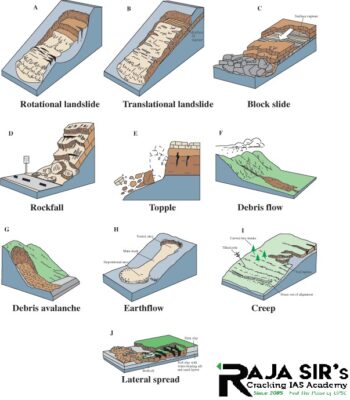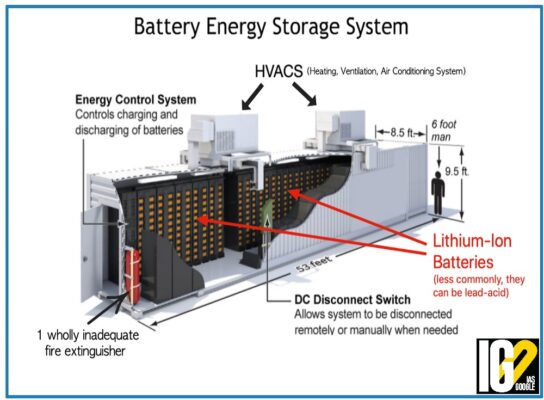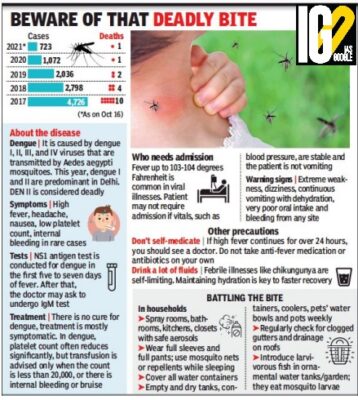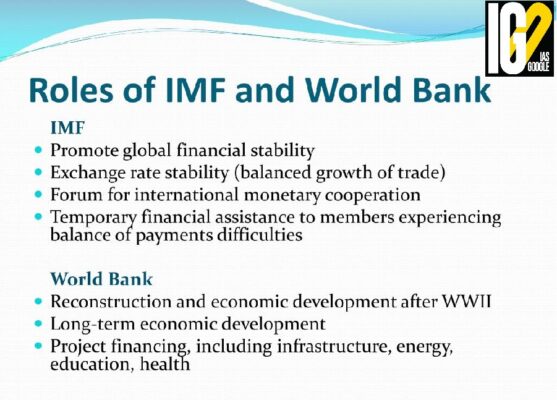- Home
- Prelims
- Mains
- Current Affairs
- Study Materials
- Test Series
20th Oct 2021
WHAT CAUSED HEAVY RAIN AND LANDSLIDES OVER SOUTHERN KERALA?
Flash floods, mudslides and landslides have been reported in most districts located between central and southern Kerala.
Highlights:



INDIA EMBARKS ON LARGE SCALE BATTERY ENERGY STORAGE SYSTEM FOR 1 GW/HOUR PROJECT
The Central government has given its approval for inviting the expression of interest for installation of 1000 MWh Battery Energy Storage System (BESS) as a pilot project.








- The rainfall is mainly a localised phenomenon triggered due to the low-pressure system formed in the Arabian Sea, which has triggered the severe weather.
- Kerala experienced heavy to very heavy rain.
- Very Heavy rain: It occurs when the precipitation rate is >7.6 mm per hour, or between 10 mm and 50 mm per hour.
- A landslide is defined as the movement of a mass of rock, debris, or earth down a slope.
- Landslides are a type of "mass wasting," which denotes any down-slope movement of soil and rock under the direct influence of gravity.
- Landslide encompasses five modes of slope movement: falls, topples, slides, spreads, and flows.
- These are further subdivided by the type of geologic material (bedrock, debris, or earth).
- Debris flows (commonly referred to as mudflows or mudslides) and rock falls are examples of common landslide types.

- Slope movement occurs when forces acting down-slope (mainly due to gravity) exceed the strength of the earth materials that compose the slope.
- Causes include factors that increase the effects of down-slope forces and factors that contribute to low or reduced strength.
- Landslides can be initiated in slopes already on the verge of movement by:
- Rainfall
- Snowmelt
- Changes In Water Level
- Stream Erosion
- Changes In Ground Water
- Earthquakes
- Volcanic Activity
- Disturbance By Human Activities
- Any combination of these factors.
- Earthquake shaking can cause landslides known as submarine landslide that can cause tsunamis that damage coastal areas.
- Restriction or even removal of populations from areas with a history of landslides
- Installation of early warning systems based on the monitoring of ground conditions such as strain in rocks and soils, slope displacement, and groundwater levels.
- Modification of slope geometry
- Using chemical agents to reinforce slope material
- Installing structures such as piles and retaining walls
- Grouting rock joints and fissures
- Diverting debris pathways
- Rerouting surface and underwater drainage.

| Southwest Monsoon | Northeast Monsoon |
| The monsoon in summers enters our country, India from the south-west direction. | Northeast monsoon enters India from northeast direction and can also be called the winter monsoon. |
| In this type of monsoon, the wind blows from sea to land. These monsoon winds carry moisture from the Indian Ocean. | In this type of monsoon, the wind blows from land to sea. |
| The trade winds enter the peninsular part of India as the south-west monsoon. | These monsoon winds carry moisture from the north-east. |
| The south-west monsoon which is called the summer monsoon has potential for destruction. But it is welcomed in India by farmers because they depend on these rains for irrigation. | Jammu and Kashmir, Himachal Pradesh and Uttarakhand experience precipitation in the form of rainfall of snowfall during the northeast monsoon. |
| This brings heavy rainfall between June month to September month. | Rainfall is experienced in the southern part of India, mainly in Kerala, Andhra Pradesh, Karnataka and Tamil Nadu during this period. |
- The decision comes as a big support to the Ministry of New and renewable which intends to achieve 450 GW renewable energy target by 2030.
- The government has allowed the state-owned Solar Energy Corp of India (SECI) to call expressions of interest (EoI) for setting up a 1 gigawatt-hour (GWh) grid-scale battery storage system.

- In a push towards “Green Energy” goals, the government intends to use energy storage system for integration of India’s Renewable energy with the country’s power system.
- Then, the energy storage system will be used as a grid element to maximize the use of the transmission system and strengthen grid stability. The objective is to save investment in the augmentation of transmission infrastructure.
- Energy Storage will be useful as an asset to balance services and for flexible operation.
- The system operator or load dispatchers (RLDCs and SLDCs) may use these storage systems for frequency control and balancing services to manage the inherent uncertainty/variations in the load due to un-generation.
- Energy Storage will be manoeuvred for the distribution system. It may be placed at the load centre to manage its peak load and other obligations.
- Under business cases, India plans to use the energy storage system developer as a merchant capacity and thereby sell it in the power market.
- Moreover, it may be utilized for any other future business models as a combination of all the above.
- Currently, India is conducting the world’s largest clean energy programme, under which it aims to achieve 175 GW of renewable capacity, including 100GW of solar power by 2022.
- According to the Central Electricity Authority of India, there will be a need for 27GW of grid-scale battery energy storage systems by 2030 with four hours of storage.
- Till date, India has crossed 100 gigawatts (GW) of installed solar and wind capacity, with another 63GW under construction as a part of its’ green energy targets.
- Battery Energy Storage System (BESS) is a technology developed for storing electric charge by using specially developed batteries.
- The underlying idea being that such stored energy can be utilized at a later time.
- BESSs are a sub-set of Energy Storage Systems (ESSs).
- Energy Storage System is a general term for the ability of a system to store energy using thermal, electro-mechanical or electro-chemical solutions.
- A BESS typically utilizes an electro-chemical solution.
- Increasing electricity demand, due to the increase in population, industrialization, and urbanization in the country, is likely to drive the India battery energy storage systems market.
- BESS can provide energy when there is a shortage of it, thus making the workflow smooth.
- Many areas in the country face several power cuts during the day, which creates hindrance in the workflow.
- BESS can hold extra power that the solar and wind energies produced for its later use, thus maximizing the use of energy generated.
- In 2019, the total electricity generated in India was 1561.1 terawatt-hours (TWh), which was higher than what is produced in 2017, 1470.3 terawatt-hours (TWh).
- In 2019, Tata Power, AES Corporation, and Mitsubishi Corporation inaugurated India's first grid-scale battery-based energy storage system in Rohini, Delhi.
- The 10 megawatts (MW) grid-connected system, owned by AES and Mitsubishi Corporation.
- Battery-based energy storage enables electricity to be stored and then delivered within milliseconds, reducing the instability of the electric grid and enabling more energy to be captured and delivered on-demand.
- Hence, increasing energy demand is expected to drive the India battery energy storage systems market during the forecast period.
- Focus will be on workers’ opportunities, which should not be denied and creation of new opportunities.
- It covered areas like the Code on Society Security 2020, Occupational Safety, Health and Working Conditions Code 2020.
- The labour code will be steeped in the idea of ease of doing business, for this the state government would ascertain the opinion of stakeholders that included workers and the management.

- In July 2021, the Supreme Court of India had struck down the old provisions for administration of tribunals relating to tenure and some other service conditions.
- However, the Central Government brought back the very same provisions for administration of tribunals in the 2021 Tribunal Reforms Act, which were struck down in July.
- The SC in September expressed its dissatisfaction over Central Government for the move, terming it as an overrule the court’s judgment.
- In response, the Union government has argued that the top court is violating the constitutionally mandated separation of powers provision, by quashing the laws already passed by the Parliament.

- The system of separation of powers divides the tasks of the state into three branches: legislative, executive and judicial.
- These tasks are assigned to different institutions in such a way that each of them can check the others.
- As a result, no one institution can become so powerful in a democracy as to destroy this system.
- The theory of separation of powers signifies mainly three formulations of Governmental powers:
- The same person should not form part of more than one of the three organs of the state.
- One organ should not interfere with any other organ of the state.
- One organ should not exercise the functions assigned to any other organ.
- India follows constitutional democracy which offers a clear separation of powers.
- Judiciary is independent of the other two branches with the power to interpret the constitution.
- Parliament has the legislative powers.
- Executive powers are vested in the President who is advised by the Union Council of Ministers headed by the Prime Minister.
- All three branches have "checks and balances" over each other to maintain the balance of power and not to exceed the constitutional limits.

- The move came after many states quit the Pradhan Mantri Fasal Bima Yojana.
- Major issues in the scheme are: High premium rates, lack of sufficient participation in tenders, inadequate underwriting capacity of the insurers etc.
- According to the data of 19 states, there is over 10% fall in enrollment of farmers under crop insurance during Kharif 2021 from last season’s 1.68 crore.
- The premium, paid by farmers is fixed at 1.5% for rabi crops, 2% for Kharif crops, and 5% for cash crops.
- The balance premium is split equally between the Centre and states.
- The working group will address the demand of an alternative model comprising sustainable underwriting capacity of insurers and rationalized premium pricing. It will submit its report in six months.
- The group will find out reasons for high premium rates and suggest mechanism to rationalize them including the option of creating a risk pool.
- Role of state governments will have to be defined as they are the implementing agencies.

- The Pradhan Mantri Fasal Bima Yojna was launched on 18th February 2016.
- It is administered by the Ministry of Agriculture & Farmers Welfare.
- It is the flagship scheme of the government for agricultural insurance in India with One Nation-One Scheme theme.
- Annual Commercial / Annual Horticultural crops, oilseeds, and food crops are covered under the scheme.
- To provide insurance coverage and financial support to the farmers due to failure of crops as a result of natural calamities, pests & diseases.
- To stabilise the income of farmers ensuring their continuance in farming.
- Encourage farmers to adopt innovative and modern agricultural practices.
- To ensure flow of credit to the agriculture sector.
- To address the challenges in the implementation of the crop insurance scheme, the Central Government has launched PMFBY 2.0 in 2020.
- Aim: To ensure quick computation and payment of claims to the farmers, proportionate to the loss of crops through a series of technological interventions.
- For north-eastern states, the Center’s share in premium subsidy increased to 90% from 50% earlier.
- Flexibility to states:
- States/UTs, given an option to choose their scale of finance for any district crop combination.
- Another option for states/UTs to run the scheme with the selection of additional risk covers.
- Cap on Centre’s Premium Subsidy:
- For unirrigated areas/crops, the Central subsidy is limited up to 30%
- For irrigated area/crops, the subsidy is limited up to 25%.
- The districts having an area under irrigationfor more than 50% will be considered as an irrigated district.
- Penalty on states:
- If a state delays to release requisite premium subsidy to insurance companies beyond a set time-limit, they will not be allowed to run the scheme in subsequent seasons.
- To conduct Crop Cutting Experiments(CCEs), and adoption of technology solutions including Smart Sampling Technique (SST).

- Dengue fever is a mosquito-borne tropical disease caused by the dengue virus.
- It is spread by bite of female mosquitoes of the Aedes genus.
- Dengue fever virus (DENV) is an RNA virus of the family Flaviviridae; genus Flavivirus.
- There are four types of dengue strains, and type II and IV are considered to be more severe and normally require hospitalization.
- The incubation period (time between exposure and onset of symptoms) ranges from 3 to 14 days.
- High fever, headache, vomiting, muscle and joint pains, and a characteristic skin rash.
- In a small proportion of cases, the disease develops into a more severe dengue hemorrhagic fever, resulting in bleeding, low levels of blood platelets and blood plasma leakage, or into dengue shock syndrome, where dangerously low blood pressure occurs.
- Children often experience symptoms similar to those of the common cold and gastroenteritis.
- Platelet count in dengue decreases as it suppresses bone marrow, which is the platelet-producing area.
- Platelet count in dengue also decreases because of blood cells affected by the disease.
- Antibodies that are produced during this period lead to massive destruction of platelets in dengue.
- Platelets, or thrombocytes, are small, colorless cell fragments in our blood that form clots and stop or prevent bleeding.
- Platelets are made in our bone marrow, the sponge-like tissue inside our bones. Bone marrow contains stem cells that develop into red blood cells, white blood cells, and platelets.
- They can be essential to surviving surgeries such as organ transplant, as well as fighting cancer, chronic diseases, and traumatic injuries.
- A vaccine for dengue fever has been approved and is commercially available in a number of countries. As of 2021, one version is commercially available, known as CYD-TDV, and sold under the brand name Dengvaxia.
- The vaccine is only recommended in individuals who have been previously infected, or in populations with a high rate of prior infection by age nine.
- Other methods of prevention include reducing mosquito habitat and limiting exposure to bites.

- In the annual meetings of the World Bank Group and the International Monetary Fund (IMF) 2021, it was suggested the need to review the role of IMF due to changing economic weight of emerging countries.
- Stress was on completing quota reforms and maintaining data integrity amid the World Bank discontinuing its Ease of Doing Business reports.
- There is a need to complete quota reforms in the IMF amid changing dynamics of developed and emerging economies including India.
- A restructuring of the Article IV consultations, under which the IMF holds bilateral discussions with its members usually every year is also being sought.
- Article IV consultation is the most powerful instrument and it needs to be restructured and sharpened to make it more useful by using the new technologies and access to public data.
- Article IV consultation reports are utilised by credit rating agencies, impacting the fund-raising capacity of countries like India.
- Former Deputy Governor of RBI states that the US and China should jointly lead the efforts on the transformation of relative quota shares in the IMF and associated reforms in the international monetary system. This is needed because:
- China could approach or even surpasses the United States in its share of global GDP at market exchange rates. So, its quota share would have to be of a magnitude similar to that of the United States.
- The share of the European Union countries, including that of the UK, will have to reduce significantly.
- The quota share of BRICS countries would have to be increased significantly.
- It is suggested that the IMF should focus on lower income countries and support other developing countries’ market funds raising activities.
- This is because most of the Asian countries including India can now raise funds on their own based on the strength of their forex reserves and do not have to necessarily go to the IMF during crisis situation.
- There should be alignment of quotas and the accompanying lending windows of the IMF to reflect the changed economic positions of countries.
- Many economic experts demand to restructure country-specific consultations being done by multilateral institutions.
- The IMF is a quota-based institution.
- Quotas are the building blocks of the IMF’s financial and governance structure. Each member’s quota determines its voting power as well as its borrowing capacity.
- Quotas are denominated in Special Drawing Rights (SDRs), the IMF’s unit of account.
- The roles of Quota can be described as:
- Resource Contributions:
- Quotas determine the maximum amount of financial resources a member is obliged to provide to the IMF.
- Voting Power:
- Quotas are a key determinant of the voting power in IMF decisions.
- Votes comprise one vote per SDR 100,000 of quota plus basic votes (same for all members).
- Access to Financing:
- Quotas determine the maximum amount of financing a member can obtain from the IMF under normal access.
- SDR Allocations:
- Quotas determine a member’s share in a general allocation of SDRs.
- Resource Contributions:
- The IMF's Board of Governors conducts general reviews of quotas at regular intervals.
- Any changes in quotas must be approved by an 85 percent majority of the total voting power, and a member’s quota cannot be changed without its consent.
- A quota formula is used to help assess members’ relative position in the world economy and it can play a role in guiding the distribution of quota increases.
- The current formula was agreed upon in 2008.
- Under Article IV consultation, the IMF holds bilateral discussions with members, usually every year.
- A staff team visits the country, collects economic and financial information, and discusses with officials the country's economic developments and policies.
- A report is prepared which summarizes the views of Executive Directors, and this summary is transmitted to the country's authorities.









 Latest News
Latest News
 General Studies
General Studies